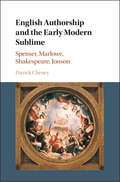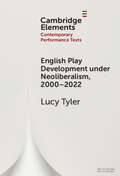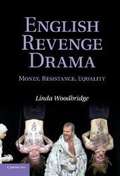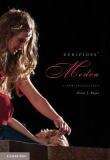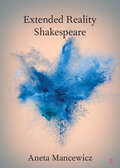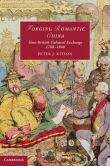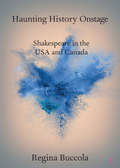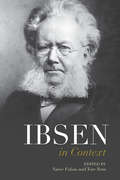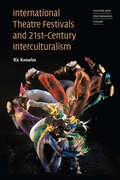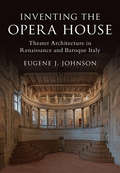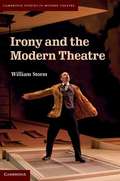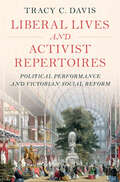- Table View
- List View
English Authorship and the Early Modern Sublime: Fictions Of Transport In Spenser, Marlowe, Jonson, And Shakespeare
by Patrick CheneyPatrick Cheney's new book places the sublime at the heart of poems and plays in late sixteenth- and early seventeenth-century England. <P><P>Specifically, Cheney argues for the importance of an 'early modern sublime' to the advent of modern authorship in Spenser, Marlowe, Shakespeare, and Jonson. Chapters feature a model of creative excellence and social liberty that helps explain the greatness of the English Renaissance. Cheney's argument revises the received wisdom, which locates the sublime in the eighteenth-century philosophical 'subject'. <P>The book demonstrates that canonical works like The Faerie Queene and King Lear reinvent sublimity as a new standard of authorship. This standard emerges not only in rational, patriotic paradigms of classical and Christian goodness but also in the eternizing greatness of the author's work: free, heightened, ecstatic. Playing a centralizing role in the advent of modern authorship, the early modern sublime becomes a catalyst in the formation of an English canon.<P> The first book to place the sublime at the heart of poems and plays in late sixteenth- and early seventeenth-century England.<P> Links recent work on the classical or medieval sublime and the modern sublime.<P> Introduces a new model of authorship featuring an aesthetics of sublimity focussing on writers such as Edmund Spenser, Christopher Marlowe, William Shakespeare, and Ben Jonson.
English Play Development under Neoliberalism, 2000–2022 (Elements in Contemporary Performance Texts)
by Lucy TylerEnglish Play Development under Neoliberalism, 2000–2022 is the first study of the institutionalising of English play development practices in the twenty-first century. It identifies the ways in which support for playwrights and text development increased beneficially during the 1990s and 2000s. It assesses bureaucratic institutional dynamics in key English producing houses as they were surveyed by two reports in 2009, and how these were experienced and transformed in the 2010s. The Element identifies in new play development innovations in the commodification and marketisation of new writing, the bureaucratisation of literary management, the structuring and restructuring of dramaturgy according to Fordist, then post-Fordist, conditions, and the necessity for commissioned artists to operate as neoliberal subjects. It concludes with attention to a liberatory horizon for play development in the English context. This title is also available as Open Access on Cambridge Core.
English Revenge Drama: Money, Resistance, Equality
by Linda WoodbridgeVengeance permeates English Renaissance drama - for example, it crops up in all but two of Shakespeare's plays. This book explores why a supposedly forgiving Christian culture should have relished such bloodthirsty, vengeful plays. A clue lies in the plays' passion for fairness, a preoccupation suggesting widespread resentment of systemic unfairness - legal, economic, political, and social. Revengers' precise equivalents - the father of two beheaded sons obliges his enemy to eat her two sons' heads - are vigilante versions of Elizabethan law, where penalties suit the crimes: thieves' hands were cut off, scolds' tongues bridled. The revengers' language of 'paying' hints at the operation of revenge in the service of economic redress. Revenge makes contact with resistance theory, justifying overthrow of tyrants, and some revengers challenge the fundamental inequity of social class. Woodbridge demonstrates how, for all their sensationalism, their macabre comedy and outlandish gore, Renaissance revenge plays do some serious cultural work.
Environmental Degradation in Jacobean Drama
by Bruce BoehrerIn Environmental Degradation in Jacobean Drama, Bruce Boehrer provides the first general history of the Shakespearean stage to focus primarily on ecological issues. Early modern English drama was conditioned by the environmental events of the cities and landscapes within which it developed. Boehrer introduces Jacobean London as the first modern European metropolis in an England beset by problems of overpopulation; depletion of resources and species; land, water and air pollution; disease and other health-related issues; and associated changes in social behavior and cultural output. In six chapters he discusses the work of the most productive and influential playwrights of the day: Shakespeare, Jonson, Middleton, Fletcher, Dekker and Heywood, exploring the strategies by which they made sense of radical ecological change in their drama. In the process, Boehrer sketches out these playwrights' differing responses to environmental issues and traces their legacy for later literary formulations of green consciousness.
Euripides' Medea
by Diane J. RayorEuripides' Medea comes alive in this new translation that will be useful for both academic study and stage production. Diane J. Rayor's accurate yet accessible translation reflects the play's inherent theatricality and vibrant poetry. The book includes an analytical introduction and comprehensive notes, and an essay on directing Medea by stage director Karen Libman. The play begins after Medea, a princess in her own land, has sacrificed everything for Jason: she helped him in his quest for the Golden Fleece, eloped with him to Greece, and bore him sons. When Jason breaks his oath to her and betrays her by marrying the king's daughter – his ticket to the throne – Medea contemplates the ultimate retribution. What happens when words deceive and those you trust most do not mean what they say? Euripides' most enduring Greek tragedy is a fascinating and disturbing story of how far a woman will go to take revenge in a man's world.
Extended Reality Shakespeare (Elements in Shakespeare Performance)
by Aneta MancewiczThis Element argues for the importance of extended reality as an innovative force that changes the understanding of theatre and Shakespeare. It shows how the inclusion of augmented and virtual realities in performance can reconfigure the senses of the experiencers, enabling them to engage with technology actively. Such engagements can, in turn, result in new forms of presence, embodiment, eventfulness, and interaction. In drawing on Shakespeare's dramas as source material, this Element recognises the growing practice of staging them in an extended reality mode, and their potential to advance the development of extended reality. Given Shakespeare's emphasis on metatheatre, his works can inspire the layering of environments and the experiences of transition between the environments both features that distinguish extended reality. The author's examination of selected works in this Element unveils creative convergences between Shakespeare's dramaturgy and digital technology.
Forging Romantic China
by Peter J. KitsonThe first major cultural study to focus exclusively on this decisive period in modern British-Chinese relations. Based on extensive archival investigations, Peter J. Kitson shows how British knowledge of China was constructed from the writings and translations of a diverse range of missionaries, diplomats, travellers, traders, and literary men and women during the Romantic period. The new perceptions of China that it gave rise to were mediated via a dynamic print culture to a diverse range of poets, novelists, essayists, dramatists and reviewers, including Jane Austen, Thomas Percy, William Jones, S. T. Coleridge, George Colman, Robert Southey, Charles Lamb, William and Dorothy Wordsworth and others, informing new British understandings and imaginings of China on the eve of the Opium War of 1839–42. Kitson aims to restore China to its true global presence in our understandings of the culture and literature of Britain in the late eighteenth and early nineteenth centuries.
Found in Translation
by J. Michael WaltonIn considering the practice and theory of translating plays into English from Classical Greek from a theatrical perspective, Found in Translation also addresses wider issues of transferring any piece of theatre from a source into a target language. The history of translating classical tragedy and comedy, here fully investigated for the first time, demonstrates how through the ages translators have, wittingly or unwittingly, appropriated Greek plays and made them reflect socio-political concerns of their own era. Chapters are devoted to topics including verse and prose, mask and non-verbal language, stage directions and subtext and translating the comic. Among the plays discussed as 'case studies' are Aeschylus' Agamemnon, Sophocles' Oedipus Tyrannus and Euripides' Medea and Alcestis. The book concludes with a consideration of the boundaries between 'translation' and 'adaptation', followed by an Appendix of every translation of Greek tragedy and comedy into English from the 1550s to the present day.
French Visual Culture and the Making of Medieval Theater
by Laura WeigertThis book revives what was unique, strange and exciting about the variety of performances that took place in the realms of the French kings and Burgundian dukes. Laura Weigert brings together a wealth of visual artifacts and practices to explore this tradition of late medieval performance located not in 'theaters' but in churches, courts, and city streets and squares. By stressing the theatricality rather than the realism of fifteenth-century visual culture and the spectacular rather than the devotional nature of its effects, she offers a new way of thinking about late medieval representation and spectatorship. She shows how images that ostensibly document medieval performance instead revise its characteristic features to conform to a playgoing experience that was associated with classical antiquity. This retrospective vision of the late medieval performance tradition contributed to its demise in sixteenth-century France and promoted assumptions about medieval theater that continue to inform the contemporary disciplines of art and theater history.
George Bernard Shaw in Context
by Brad KentWhen Shaw died in 1950, the world lost one of its most well-known authors, a revolutionary who was as renowned for his personality as he was for his humour, humanity, and rebellious thinking. He remains a compelling figure who deserves attention not only for how influential he was in his time, but for how relevant he is to ours. This collection sets Shaw's life and achievements in context, with 42 scholarly essays devoted to subjects that interested him and defined his work. Contributors explore a wide range of themes, moving from factors that were formative in Shaw's life, to the artistic work that made him most famous and the institutions with which he worked, to the political and social issues that consumed much of his attention, and, finally, to his influence and reception. Presenting fresh material and arguments, this collection will point to new directions of research for future scholars.
Greek Theatre Performance
by David WilesIn this book, David Wiles introduces ancient Greek theater to students and enthusiasts interested in knowing how the plays were performed. Theater was a ceremony bound up with fundamental activities in ancient Athenian life and Wiles explores those elements that created the theater of the time. Actors rather than writers are the book's main concern and Wiles examines how the actor used the resources of story-telling, dance, mask, song and visual action to create a large-scale event that would shape the life of the citizen community.
Greek Tragic Style
by R. B. RutherfordGreek tragedy is widely read and performed, but outside the commentary tradition detailed study of the poetic style and language of Aeschylus, Sophocles and Euripides has been relatively neglected. This book seeks to fill that gap by providing an account of the poetics of the tragic genre. The author describes the varied handling of spoken dialogue and of lyric song; major topics such as vocabulary, rhetoric and imagery are considered in detail and illustrated from a broad range of plays. The contribution of the chorus to the dramas is also discussed. Characterisation, irony and generalising statements are treated in separate chapters and these topics are illuminated by comparisons which show not only what is shared by the three major dramatists but also what distinguishes their practice. The book sheds light both on the genre as a whole and on many particular passages.
Hamlet (The New Cambridge Shakespeare)
by William ShakespearePhilip Edwards deals succinctly with the exhaustive commentary and controversy which Hamlet has provoked in the manifestation of its tragic energy. Robert Hapgood has contributed a new section on prevailing critical and performance approaches to the play in this updated edition. He discusses recent film and stage performances and actors of the Hamlet role as well as directors of the play. His account of new scholarship stresses the role of memory in the play and the impact of feminist and performance studies upon it. [This text is listed as an example that meets Common Core Standards in English language arts in grades 11-12 at http://www.corestandards.org.]
Harrison Birtwistle's Operas and Music Theatre
by David BeardDavid Beard presents the first definitive survey of Harrison Birtwistle's music for the opera house and theatre, from his smaller-scale works, such as Down by the Greenwood Side and Bow Down, to the full-length operas, such as Punch and Judy, The Mask of Orpheus and Gawain. Blending source study with both music analysis and cultural criticism, the book focuses on the sometimes tense but always revealing relationship between abstract musical processes and the practical demands of narrative drama, while touching on theories of parody, narrative, pastoral, film, the body and community. Each stage work is considered in terms of its own specific musico-dramatic themes, revealing how compositional scheme and dramatic conception are intertwined from the earliest stages of a project's genesis. The study draws on a substantial body of previously undocumented primary sources and goes beyond previous studies of the composer's output to include works unveiled from 2000 onwards.
Haunting History Onstage: Shakespeare in the USA and Canada (Elements in Shakespeare Performance)
by Regina BuccolaIn 2016, Chicago Shakespeare Theater and the Stratford Festival of Canada mounted marathons through Shakespearean history to commemorate the 400th anniversary of the death of Shakespeare with Tug of War and Breath of Kings. Both productions invited parallels to contemporary political events in their promotion and design, just as the original performances of these works in the Shakespearean era used past events to comment on present realities. Endurathons for cast and audience alike, Tug of War and Breath of Kings used double-casting, stylized treatments of violence and 'firsts' for each company to sweeten the bitter pill of these historical narratives.
Home on the Stage
by Nicholas GreneAs a serious drama set in an ordinary middle-class home, Ibsen's A Doll's House established a new politics of the interior that was to have a lasting impact upon twentieth-century drama. In this innovative study, Nicholas Grene traces the changing forms of the home on the stage through nine of the greatest of modern plays and playwrights. From Chekhov's The Cherry Orchard through to Williams's A Streetcar Named Desire, domestic spaces and personal crises have been employed to express wider social conditions and themes of class, gender and family. In the later twentieth century and beyond, the most radically experimental dramatists created their own challenging theatrical interiors, including Beckett in Endgame, Pinter in The Homecoming and Parks in Topdog/Underdog. Grene analyses the full significance of these versions of domestic spaces to offer fresh insights into the portrayal of the naturalistic environment in modern drama.
Ibsen in Context (Literature in Context)
by Narve Fulsås Tore RemHenrik Ibsen, the 'Father of Modern Drama', came from a seemingly inauspicious background. What are the key contexts for understanding his appearance on the world stage? This collection provides thirty contributions from leading scholars in theatre studies, literary studies, book history, philosophy, music, and history, offering a rich interdisciplinary understanding of Ibsen's work, with chapters ranging across cultural and aesthetic contexts including feminism, scientific discovery, genre, publishing, music, and the visual arts. The book ends by charting Ibsen's ongoing globalization and gives valuable overviews of major trends within Ibsen studies. Accessibly written, while drawing on the most recent scholarship, Ibsen in Context provides unique access to Ibsen the man, his works, and their afterlives across the world.
Ibsen’s Houses
by Mark B. SandbergHenrik Ibsen's plays came at a pivotal moment in late nineteenth-century European modernity. They engaged his public through a strategic use of metaphors of house and home, which resonated with experiences of displacement, philosophical homelessness, and exile. The most famous of these metaphors - embodied by the titles of his plays A Doll's House, Pillars of Society, and The Master Builder - have entered into mainstream Western thought in ways that mask the full force of the reversals Ibsen performed on notions of architectural space. Analyzing literary and performance-related reception materials from Ibsen's lifetime, Mark B. Sandberg concentrates on the interior dramas of the playwright's prose-play cycle, drawing also on his selected poems. Sandberg's close readings of texts and cultural commentary present the immediate context of the plays, provide new perspectives on them for international readers, and reveal how Ibsen became a master of the modern uncanny.
International Theatre Festivals and Twenty-First-Century Interculturalism (Theatre and Performance Theory)
by Ric KnowlesRic Knowles' study is a politically urgent, erudite intervention into the ecology of theatre and performance festivals in an international context. Since the 1990s there has been an exponential increase in the number and type of festivals taking place around the world. Events that used merely to be events are now 'festivalized': structured, marketed, and promoted in ways that stress urban centres as tourist destinations and “creative cities” as targets of corporate enterprise. Ric Knowles examines the structure, content, and impact of international festivals that draw upon and represent multiple cultures and the roles they play in one of the most urgent processes of our times: intercultural negotiation and exchange. Covering a vast geographical sweep and exploring festival models both new and ancient, the work sets compelling new standards of practice for post-pandemic festivals.
Inventing the Opera House: Theater Architecture In Renaissance And Baroque Italy
by Eugene J. JohnsonIn this book, Eugene J. Johnson traces the invention of the opera house, a building type of world wide importance. <P><P>Italy laid the foundation theater buildings in the West, in architectural spaces invented for the commedia dell'arte in the sixteenth century, and theaters built to present the new art form of opera in the seventeenth. Rulers lavished enormous funds on these structures. Often they were among the most expensive artistic undertakings of a given prince. They were part of an upsurge of theatrical invention in the performing arts. At the same time, the productions that took place within the opera house could threaten the social order, to the point where rulers would raze them. Johnson reconstructs the history of the opera house by bringing together evidence from a variety of disciplines, including music, art, theatre, and politics. Writing in an engaging manner, he sets the history of the opera house within its broader early modern social context.<P> This is the only book, since the 1930s, to cover this subject, and the only English language one to ever be produced.<P> Sets the subject into a broad context of the arts, politics, and social history of the period.<P> The book aims to reach both specialists and the general reader, making it appealing to those who know the field well and those who do not care to plow through scholarly jargon.
Irony and the Modern Theatre
by William StormIrony and theatre share intimate kinships, not only regarding dramatic conflict, dialectic or wittiness, but also scenic structure and the verbal or situational ironies that typically mark theatrical speech and action. Yet irony today, in aesthetic, literary and philosophical contexts especially, is often regarded with skepticism - as ungraspable, or elusive to the point of confounding. Countering this tendency, Storm advocates a wide-angle view of this master trope, exploring the ironic in major works by playwrights including Chekhov, Pirandello and Brecht, and in notable relation to well-known representative characters in drama from Ibsen's Halvard Solness to Stoppard's Septimus Hodge and Wasserstein's Heidi Holland. To the degree that irony is existential, its presence in the theatre relates directly to the circumstances and the expressiveness of the characters on stage. This study investigates how these key figures enact, embody, represent and personify the ironic in myriad situations in the modern and contemporary theatre.
Julius Caesar (The New Cambridge Shakespeare)
by William Shakespeare Marvin SpevackMarga Munkelt has added a new section and pictures to the Introduction of this updated edition of Julius Caesar. It surveys stage and critical interpretations since the 1980's of Shakespeare's most famous Roman play. The reading list has also been brought up to date.
King Henry V (The New Cambridge Shakespeare)
by William Shakespeare Andrew GurrFor this updated edition of Shakespeare's most celebrated war play, Andrew Gurr has added a new section to his introduction which considers recent critical and stage interpretations. He analyzes the play's double vision of Henry as both military hero and self-seeking individual and demonstrates how the patriotic declarations of the Chorus are contradicted by the play's action. Gurr analyzes the play's more controversial sequences in the context of Elizabethan thought, in particular, the studies of the laws and morality of war written in the years before Henry V. An updated reading list completes the edition.
King Richard II (The New Cambridge Shakespeare)
by William Shakespeare Andrew GurrAndrew Gurr has added a new section to the Introduction of this updated edition in which he describes the growing interest in new historical and political analysis of the play. He also surveys a number of important professional theatre productions and guides the reader through scholarly criticism of recent years. The Reading List has been revised and augmented.
Liberal Lives and Activist Repertoires: Political Performance and Victorian Social Reform
by Tracy C. DavisThis ambitious study traces the strategies of human rights activists to show how world-changing reform movements were shaped by women and men from modest backgrounds who were deeply attuned to the power of performance. Tracy C. Davis explores nineteenth-century reform campaigns through the pioneering work of a family of activists – prominent anti-slavery lecturer George Thompson, his daughter Amelia (the first female theatre and music critic for a British daily newspaper) and her husband, the political organizer Frederick Chesson. Engaging in some of the most important social struggles of the late Georgian and Victorian periods – including abolition, enfranchisement, and anti-genocide - this book reveals how two generations' insights into performance consolidated into activist tactics that persist today. Characterised by a skilful deployment of performance theory alongside deep and wide-ranging historical knowledge, this ground-breaking work demonstrates what 'dramaturgy' can teach us about 'history'.
